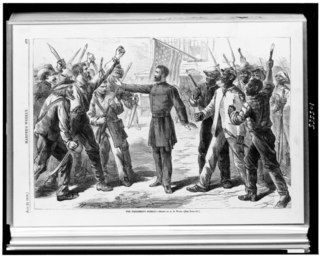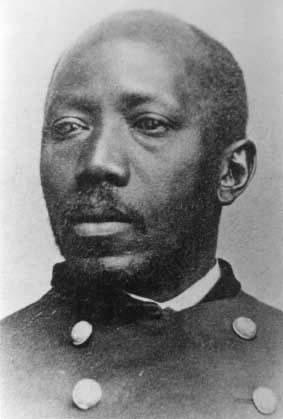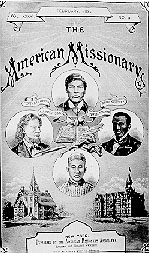Related Research Articles

Booker Taliaferro Washington was an American educator, author, and orator. Between 1890 and 1915, Washington was the primary leader in the African-American community and of the contemporary Black elite.

Henry Highland Garnet was an American abolitionist, minister, educator, orator, and diplomat. Having escaped as a child from slavery in Maryland with his family, he grew up in New York City. He was educated at the African Free School and other institutions, and became an advocate of militant abolitionism. He became a minister and based his drive for abolitionism in religion.

The Bureau of Refugees, Freedmen, and Abandoned Lands, usually referred to as simply the Freedmen's Bureau, was a U.S. government agency of early post American Civil War Reconstruction, assisting freedmen in the South. It was established on March 3, 1865, and operated briefly as a federal agency after the War, from 1865 to 1872, to direct provisions, clothing, and fuel for the immediate and temporary shelter and supply of destitute and suffering refugees and freedmen and their wives and children.
During the history of the Latter Day Saint movement, the relationship between Black people and Mormonism has included enslavement, exclusion and inclusion, and official and unofficial discrimination. Black people have been involved with the Latter Day Saint movement since its inception in the 1830s. Their experiences have varied widely, depending on the denomination within Mormonism and the time of their involvement. From the mid-1800s to 1978, Mormonism's largest denomination – the Church of Jesus Christ of Latter-day Saints – barred Black women and men from participating in the ordinances of its temples necessary for the highest level of salvation, prevented most men of Black African descent from being ordained into the church's lay, all-male priesthood, supported racial segregation in its communities and schools, taught that righteous Black people would be made white after death, and opposed interracial marriage. The temple and priesthood racial restrictions were lifted by church leaders in 1978. In 2013, the church disavowed its previous teachings on race for the first time.
An African American is a citizen or resident of the United States who has origins in any of the black populations of Africa. African American-related topics include:

Martin Robison Delany was an American abolitionist, journalist, physician, military officer and writer who was arguably the first proponent of black nationalism. Delany is credited with the Pan-African slogan of "Africa for Africans." Born as a free person of color in Charles Town, Virginia, now West Virginia, and raised in Chambersburg and Pittsburgh, Pennsylvania, Delany trained as a physician's assistant. During the cholera epidemics of 1833 and 1854 in Pittsburgh, Delany treated patients, even though many doctors and residents fled the city out of fear of contamination. In this period, people did not know how the disease was transmitted.

The American Missionary Association (AMA) was a Protestant-based abolitionist group founded on September 3, 1846 in Albany, New York. The main purpose of the organization was abolition of slavery, education of African Americans, promotion of racial equality, and spreading Christian values. Its members and leaders were of both races; The Association was chiefly sponsored by the Congregationalist churches in New England. The main goals were to abolish slavery, provide education to African Americans, and promote racial equality for free Blacks. The AMA played a significant role in several key historical events and movements, including the Civil War, Reconstruction, and the Civil Rights Movement.

Lincoln Cemetery is a historically African American cemetery in Blue Island, Illinois, United States. The cemetery is about 112 acres (45 ha) with over 16,000 interments.

Lucy Craft Laney was an American educator who in 1883 founded the first school for black children in Augusta, Georgia. She was principal for 50 years of the Haines Institute for Industrial and Normal Education.
The civil rights movement (1865–1896) aimed to eliminate racial discrimination against African Americans, improve their educational and employment opportunities, and establish their electoral power, just after the abolition of slavery in the United States. The period from 1865 to 1895 saw a tremendous change in the fortunes of the Black community following the elimination of slavery in the South.
African Americans are the second largest census "race" category in the state of Tennessee after whites, making up 17% of the state's population in 2010. African Americans arrived in the region prior to statehood. They lived both as slaves and as free citizens with restricted rights up to the Civil War.

Emmett Jay Scott was an African American journalist, newspaper editor, academic, and government official who was Booker T. Washington's closest advisor at the Tuskegee Institute. He was responsible for maintaining Washington's nationwide "Tuskegee machine," with its close links to black business leadership, white philanthropists, and Republican politicians from the local level to the White House.
Robert Lloyd Smith was an educator, businessman, and Republican politician who served two terms in the Texas Legislature. Born a free black in Charleston, South Carolina in 1861, he moved to Texas about 1880. He served as principal of the Oakland Normal School in Colorado County in 1885. In 1890 he founded the Farmer's Home Improvement Society, a farmer's cooperative association whose purpose was to help poor blacks lift themselves out of poverty. He was first elected to the legislature in 1895 and served until 1899. He was the last African-American to serve in the Texas State Legislature until Barbara Jordan's election in the 1960s. He was a delegate to the Republican National Convention in 1896. In 1902, he was appointed by President Theodore Roosevelt as Deputy U.S. Marshal for the Eastern District of Texas. He was an associate of Booker T. Washington and also served as a trustee of the Jeanes Foundation. He was married to Ruby Cobb and had two adopted children. He is depicted at the lower left on the Black Legislators Monument erected in 2010 at the Texas State Cemetery.

John Wesley Cromwell was a lawyer, teacher, civil servant, journalist, historian, and civil rights activist in Washington, D.C. He was among the founders of the Bethel Literary and Historical Society and the American Negro Academy, both based in the capital. He worked for decades in administration of the US Post Office.
Harlem Academy School, or School #2, was a school for African Americans in Tampa, Florida. Christina Meacham, Zacariah D. Greene and Blanche Armwood served as principals at the school. It was originally built with support from the Freedmens Bureau.
Robert Mara Adger Jr. was a businessman and bibliophile in Philadelphia. His family owned a collectibles shop and lived adjacent. He became a member of the Banneker Institute at the age of 17 and became its president in his mid twenties. He amassed an important collection of books and periodicals by and about African Americans and donated it for posterity. The "Catalogue of rare books on slavery and negro authors on science, history, poetry, religion, biography, etc." was printed from the holdings in his private collection. In 1981, Rare Afro-Americana: A Reconstruction of the Adger Library was published.
William H. Moore was a state legislator in North Carolina. He served in the North Carolina House of Representatives during the Reconstruction era. He represented New Hanover County and served with other African Americans in the state legislature. His post office was in Wilmington, North Carolina. He served with Henry Brewington and Alfred Lloyd who also represented New Hanover in the 1874-1875 session. All three were African Americans.

William Grant High School was a public high school for African Americans in Covington, Kentucky. It also served African American students from surrounding areas who were not allowed to attend the whites-only schools in the county. The elementary and secondary schools that became known as Lincoln-Grant School were in a school built on 7th Street until they were relocated to a new building at 824 Greenup. The school closed after desegregation and its students transferred to Holmes High School, The elementary school continued on until 1976. The Northern Kentucky Community Center occupied the school after it clsoed. In 2017 it became the Lincoln Grant Scholar House housing single parents with low incomes. Joseph M. Walton's The Life and Legacy of Lincoln School, Covington, Kentucky, 1866-1976 was published in 2010. He graduated from the school with honors in 1958. The school was listed on the National Register of Historical Places in 2013. It is in the Emery-Price Historic District.

Swift Memorial College was a private historically Black college established by the Presbyterian church that operated from 1883 to 1952, in Rogersville, Tennessee, United States. It was established after a state law ended access for African Americans to Maryville College. Like many other early HBCU's, the school curricula in the early years was focused on high school and normal school; later it operated as a junior college. It also served as a boarding school. It closed after desegregation.

Rev. William Henderson Franklin (1852–1935) was an American educator, minister, journalist, and school founder. Franklin dedicated his life to the education of Black children in rural Tennessee during the time of racial segregation. He founded Swift Memorial College in 1883, and served as the principal until 1926. He was the first minister the congregation at St. Marks Presbyterian Church in Rogersville, Tennessee. He was also known as W.H. Franklin.
References
- 1 2 Washington, Booker T. (November 23, 1909). The Story of the Negro: The Rise of the Race from Slavery. Doubleday, Page. ISBN 9781105120381 – via Google Books.
- ↑ Zelade, Richard (May 16, 2011). Lone Star Travel Guide to Central Texas. Taylor Trade Publications. ISBN 9781589796089 – via Google Books.
- 1 2 "Colorado County Historical Markers". www.coloradocountyhistory.org.
- ↑ "Oakland Normal School". Texas Historical Markers.
- ↑ "Smith, Robert Lloyd | Encyclopedia.com". www.encyclopedia.com.
- ↑ Kletzing, Henry F.; Crogman, William Henry (November 23, 1898). "Progress of a Race, Or The Remarkable Advancement of the American Negro: From the Bondage of Slavery, Ignorance and Poverty to the Freedom of Citizenship, Intelligence, Affluence, Honor and Trust". J.L. Nichols – via Google Books.
- ↑ "The Southern Workman". 1902.
29°36′05″N96°49′51″W / 29.6013°N 96.8308°W